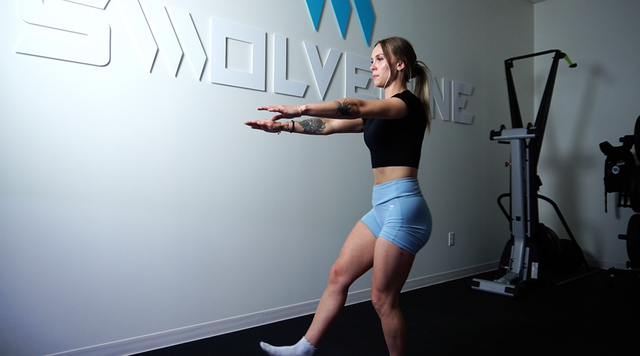The kettlebell around the world is a deceptively simple yet highly effective exercise for improving core stability, shoulder resilience, and anti-rotational strength. Often underestimated, this dynamic movement challenges your posture, proprioception, and muscular coordination with every rotation.
Whether you're a beginner or seasoned athlete, the around the world exercise provides scalable benefits that enhance functional performance. This complete guide will break down the benefits, technique, and variations—giving you everything you need to integrate it into your routine with precision.
Benefits of the Kettlebell Around the World
1. Improves Anti-Rotational Core Strength
As the kettlebell moves around your body, your core must resist twisting forces that would otherwise compromise spinal stability. This trains the obliques and transverse abdominis in a functional and safe way.
“Anti-rotation core exercises like this one are vital for enhancing lumbar spine stability and injury prevention,” explains Dr. Stuart McGill, Journal of Strength and Conditioning Research.
2. Enhances Shoulder Stability and Scapular Control
Controlling the kettlebell’s movement around your torso forces your rotator cuff and scapular stabilizers to remain engaged. This reinforces proper mechanics, especially in overhead and pressing athletes.
3. Builds Grip Strength and Forearm Endurance
Because of the kettlebell’s unique offset mass, your grip must work overtime to maintain control. This leads to improved wrist, hand, and forearm strength—especially valuable for lifters, climbers, and grapplers.
4. Boosts Coordination and Proprioception
This continuous motion requires body awareness, timing, and balance. It activates stabilizer muscles and refines movement efficiency across multiple planes of motion.
How to Perform the Kettlebell Around the World: Step-by-Step Guide
Step 1: Set Your Starting Position
-
Stand upright, feet shoulder-width apart, with a light kettlebell in both hands.
-
Brace your core and depress your shoulders slightly.
Step 2: Begin the Rotation
-
Release one hand and guide the kettlebell laterally behind your back.
-
Pass it smoothly to your opposite hand behind your body.
Step 3: Complete the Full Circle
-
Continue rotating the kettlebell in a 360-degree arc around your hips.
-
After several reps, reverse direction and rotate the opposite way.
Key Muscles Worked
-
Core: Transverse abdominis, rectus abdominis, internal/external obliques
-
Shoulders: Deltoids, rotator cuff
-
Back: Rhomboids, lower traps, erector spinae
-
Forearms and Grip
According to Behm and Colado, Sports Medicine, exercises involving dynamic stabilization and trunk control—like kettlebell drills—are highly effective in improving athletic performance and trunk strength.
Common Mistakes to Avoid
Letting the Hips Rotate
If your hips rotate with the kettlebell, you’re losing the anti-rotational benefit. Keep the hips locked forward and resist the pull of the bell.
Choosing a Weight That’s Too Heavy
Using a kettlebell that's too heavy can cause your shoulder to shrug or rotate out of position. Start light to build smooth, controlled mechanics.
Rushed Transitions
Sloppy hand-offs behind the back can lead to dropped kettlebells and broken form. Focus on slow, deliberate control.
Kettlebell Around the World Variations
Single Direction Sets
Perform 5–10 reps clockwise, then repeat counterclockwise. This increases time under tension and creates symmetrical core activation.
Around the Head
Instead of circling your waist, move the kettlebell around your head while maintaining a tight core and shoulder engagement.
Marching Around the World
Add a light march during the rotation for an added balance and coordination challenge.
Programming Recommendations
As a Warm-Up
-
2–3 sets of 10 revolutions per direction
-
Pair with shoulder circles or hip mobility drills
As a Core Finisher
-
3 sets of 30 seconds per direction
-
Combine with planks or carries for a complete anti-rotation set
In Circuits or Conditioning
-
Alternate between swings, around the worlds, and lunges for a high-output total-body routine
“Incorporating rotational and anti-rotational drills improves muscle recruitment and prepares the nervous system for performance,” notes Coach Mike Boyle, StrengthCoach.com.
Conclusion: Why This Exercise Belongs in Every Program
The kettlebell around the world is a unique hybrid of mobility, stability, and control. It enhances functional strength, builds core resilience, and increases joint integrity in the shoulders—all with minimal equipment and low risk.
As long as form is prioritized and load is appropriately scaled, this movement offers performance benefits across disciplines—from CrossFit to rehab. Include it in your warm-up, recovery circuits, or finisher sets to build a stronger, more stable foundation.
Ready to build bulletproof shoulders and a resilient core? Add the kettlebell around the world to your weekly training and feel the difference in your lifts, posture, and stability.
Would you like this formatted into a Google Doc or Canva graphic for content marketing or coaching handouts?
Find similar articles:
Fitness






